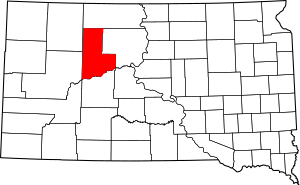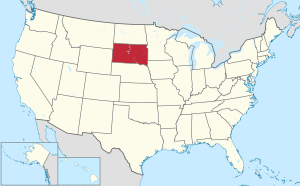Ziebach County, South Dakota facts for kids
Quick facts for kids
Ziebach County
|
|
|---|---|

Ziebach County Courthouse
|
|

Location within the U.S. state of South Dakota
|
|
 South Dakota's location within the U.S. |
|
| Country | |
| State | |
| Founded | 1911 |
| Named for | Frank M. Ziebach |
| Seat | Dupree |
| Largest city | Dupree |
| Area | |
| • Total | 1,971 sq mi (5,100 km2) |
| • Land | 1,961 sq mi (5,080 km2) |
| • Water | 9.3 sq mi (24 km2) 0.5% |
| Population
(2020)
|
|
| • Total | 2,413 |
| • Estimate
(2023)
|
2,322 |
| • Density | 1.2243/sq mi (0.47269/km2) |
| Time zone | UTC−7 (Mountain) |
| • Summer (DST) | UTC−6 (MDT) |
| Congressional district | At-large |
Ziebach County is a special place in South Dakota, USA. In 2020, about 2,413 people lived there. Its main town, or county seat, is Dupree. It's also the very last county in the United States if you list them all in alphabetical order!
What makes Ziebach County unique is that it's entirely located within Native American reservations. Most of the county is part of the Cheyenne River Indian Reservation, and a smaller part is in the Standing Rock Indian Reservation.
History of Ziebach County
A long time ago, in 1877, a county called Ziebach was first created in what was then Dakota Territory. However, after South Dakota became a state, this first county was closed down in 1898. Its land became part of Pennington and Stanley counties.
The Ziebach County we know today was officially created by the South Dakota government on February 1, 1911. It was fully set up by April 22 of that year. This new Ziebach County included parts of older counties that no longer exist, like Schnasse, Armstrong, and Sterling.
The county was named after Frank M. Ziebach. He was an important political figure in the Dakota Territory between 1861 and 1889. Before the county was formed, the area was used by trappers. For a short time around 1907, it was even a reservation for Ute Native Americans who had moved from Utah and Wyoming.
In the early 1900s, many cattle were raised here. But when the railroad didn't come through the area, the cattle business slowed down. Some people also started small farms on the best land.
Geography and Nature
Ziebach County is located in the Great Plains region. This means it has rolling grasslands and many interesting hills called buttes.
The Cheyenne River flows along the southern edge of the county. The Moreau River flows through the northern part. Cherry Creek also flows through the lower part, emptying into the Cheyenne River. The land is mostly rolling hills with some flat-topped buttes. There are also many small valleys and ditches created by water. Some areas are used for farming and raising cattle.
The land generally slopes downwards towards the south and east. The highest point in the county (besides the special Thunder Butte) is near its northwest corner, about 2,582 feet (787 meters) above sea level.
Ziebach County covers a total area of about 1,971 square miles (5,105 square kilometers). Most of this is land (1,961 square miles or 5,079 square kilometers), with a small amount of water (9.3 square miles or 24 square kilometers). As mentioned, almost all of the county is within the Cheyenne River Indian Reservation. A small part in the very north is within the Standing Rock Indian Reservation. Ziebach is one of five counties in South Dakota that are entirely within Native American reservation lands.
Famous Buttes
The buttes are the highest points in Ziebach County. Here are some of them:
- Bessie Butte (2,474 feet or 754 meters)
- Eagle Butte (2,484 feet or 757 meters)
- Gray Butte (2,316 feet or 706 meters)
- High Elk Hill (2,395 feet or 730 meters)
- Joshua Butte (2,165 feet or 660 meters)
- Marple Butte (2,484 feet or 757 meters)
- Mud Butte (2,500 feet or 762 meters)
- Mud Butte (2,365 feet or 721 meters)
- Rattlesnake Butte (2,411 feet or 735 meters)
- Saint Patrick Butte (2,356 feet or 718 meters)
- Squaw Teat Butte (2,365 feet or 721 meters)
- Thunder Butte (2,733 feet or 833 meters)
Main Roads
These are the most important roads that go through Ziebach County:
Neighboring Counties
Ziebach County shares its borders with these other counties:
- Corson County - to the north
- Dewey County - to the east
- Stanley County - to the southeast
- Haakon County - to the south
- Pennington County - to the southwest
- Meade County - to the west
- Perkins County - to the northwest
Protected Natural Areas
- Bednor Lake State Game Production Area
- Cheyenne State Game Production Area (part)
- Grand River National Grassland (part)
Lakes and Reservoirs
- Bedners Dam
- K C Dam
- Rattlesnake Lake
People of Ziebach County
| Historical population | |||
|---|---|---|---|
| Census | Pop. | %± | |
| 1920 | 3,718 | — | |
| 1930 | 4,039 | 8.6% | |
| 1940 | 2,875 | −28.8% | |
| 1950 | 2,606 | −9.4% | |
| 1960 | 2,495 | −4.3% | |
| 1970 | 2,221 | −11.0% | |
| 1980 | 2,308 | 3.9% | |
| 1990 | 2,220 | −3.8% | |
| 2000 | 2,519 | 13.5% | |
| 2010 | 2,801 | 11.2% | |
| 2020 | 2,413 | −13.9% | |
| 2023 (est.) | 2,322 | −17.1% | |
| U.S. Decennial Census 1790-1960 1900-1990 1990-2000 2010-2020 |
|||
Population in 2020
According to the 2020 census, there were 2,413 people living in Ziebach County. There were 732 households (groups of people living together) and 528 families. On average, there were about 1.2 people per square mile.
Population in 2010
In the 2010 census, Ziebach County had 2,801 people. There were 836 households and 638 families. The population density was about 1.4 people per square mile.
The people in the county were mostly Native Americans (74.9%). About 21.8% were white. A small number of people were from other racial backgrounds. About 3.1% of the population identified as Hispanic or Latino.
Many households (53.7%) had children under 18 living with them. The average household had 3.35 people, and the average family had 3.82 people. The average age of people in the county was 25.4 years old.
Towns and Places
Cities
- Dupree (This is the main town and county seat)
- Eagle Butte (Only part of this city is in Ziebach County)
Census-Designated Places (CDPs)
These are areas that are like towns but are not officially incorporated as cities:
- Bridger
- Cherry Creek
Small Communities (Unincorporated)
These are even smaller places that don't have their own local government:
- Chase
- Glad Valley
- Iron Lightning
- Red Elm
- Red Scaffold
- Thunder Butte
Unorganized Areas
Ziebach County doesn't divide itself into smaller areas called townships. Instead, it has three "unorganized territories" which are managed directly by the county government: Dupree, North Ziebach, and South Ziebach.
Images for kids
See also
 In Spanish: Condado de Ziebach para niños
In Spanish: Condado de Ziebach para niños


